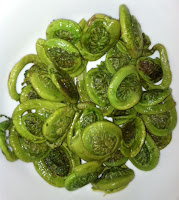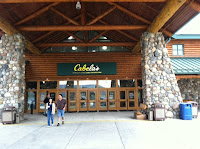http://civilwarbummer.com/alfacgiapi Fiddlehead Ferns and the First Snow Fall
During a recent visit to Pennsylvania, I experienced some firsts. My mom and I visited Cabela’s, a huge sporting goods store about an hour west of Allentown, my home town. Cabela’s is like a play ground for hunters and fishermen, but they also have great outdoor wear for active individuals. When you first walk into Cabela’s, you will either be entranced or offended by their endless array of wildlife taxidermies. I loved the huge aquarium that wraps around one entire wall and is filled with big freshwater fish and turtles. And I did buy some outdoor wear which came in handy for the first, and very early, snowfall of the year.
Hunting and fishing isn’t for everyone, but growing up in PA, I was exposed to such sports at an early age. My dad used to hunt deer in his back yard in the country. I couldn’t kill an animal myself, but as a child I loved to shoot target practice with a bow and arrow, and rifles. However, I do understand the necessity to keep the deer population under control, otherwise they may end up dead on the side of the road.
We look to fish or fish oil supplements to get our omega-3 fats which have been shown to help fight inflammation, lower cholesterol, ward off dementia and even combat depression. If we ate wild game as one of our protein sources, we’d actually get some omega-3’s as well. Wild animals live on a diet of grasses and bugs, naturally rich in omega-3’s. We’d also get a desirable ratio of omega-6’s to omega-3’s. The goal is to eat a diet with a ratio of 4g of omega-6 fats or less for each 1g of omega-3’s (4:1 or less). Poultry has a ratio of 16:1 and venison is 3:1. Free-range, grass-fed beef is also 3:1. Plus these “red” meats provide significant sources of iron, B12, selenium and zinc; minerals that are essential for transporting oxygen rich blood to working muscles and for building your body’s own antioxidant defense system. Just some food for thought when making protein choices.
My mom’s boyfriend is an avid fisherman who does what’s called “catch and release.” The fish go back in the water and instead of bringing home fish he brings home stories about the one that got away. During his recent fishing trip to Canada, he also brought back some fiddleheads.
While visiting my mom, she said, “There are some fiddleheads in the freezer if you want to try them.” I said, “What are fiddleheads?” My mom said, “They’re some kind of vegetable Bill gets from Canada. He says the people there love them.” I couldn’t believe there was a vegetable, native to North America that I had never heard of. I quickly pulled out my iPhone and fervently did some research to learn that the Fiddlehead fern is native to Canada, mostly found in the coastal regions of British Columbia as well as Ontario and Quebec. They’re also found in the moist meadows and riverbanks of Vermont and Maine. I thought, “So, they are wild harvested. That’s a good sign.”
Fiddleheads are the first greens to “spring up” in the spring. They show up after the last snow fall and they must be picked within a month’s time, before they change from a tightly wound looking spiral (or frond), and unfurl into a full fern, at which point they become too bitter to eat. They also must be cooked and cannot be eaten raw, because they tend to hold microflora in their tightly coiled fronds which can cause symptoms of a food borne illness. However, it seems that the microflora, like the microflora in our bodies, may actually be what make fiddleheads so resilient.
Fiddleheads are rich in protein and fiber. They provide 50% of the Daily Value for vitamins A & C plus significant amounts of riboflavin, niacin, manganese, copper, magnesium, iron, potassium, phosphorus, zinc and calcium.
Dr. John DeLong, a researcher from Nova Scotia Canada, claims that fiddleheads also provide those coveted omega-3 fatty acids, particularly the EPA omega-3 fats, which up to this point I thought only came from animal sources. Upon further research, I learned that EPA is found in some plants, primarily microalgae, which could be where fiddleheads get their EPA. However, while digging a little deeper, I also learned that some plants, as a defense against certain types of fungi, particularly “water molds,” will convert the omega-3 Alpha-linolenic Acid (ALA), into EPA. Perhaps the young fiddleheads protect themselves against these invading molds by converting ALA to EPA, which, like in humans, is essential for bolstering the immune system. So then I thought, “Hmm, if plants use EPA as a defense against “water molds,” could people do the same?”
After some research on PubMed, I found over 100 articles that say just that. EPA can help alleviate “allergic rhinitis,” such as that which I experience while visiting PA where mold is prevalent because of the damp environment. In fact, I sneeze incessantly the entire time I’m in PA. Perhaps I should eat more fiddleheads next time, and be sure to take my Nordic Naturals Ultimate Omega Xtra which contains 800mg of EPA & 400mg of DHA per 2 capsules. They are the best on the market so I have to let people know.
If you are ever fortunate enough to try fiddlehead ferns, and it’s really just so you can say you’ve had them, you must follow these instructions to prepare them. They could be just what the doctor ordered to boost your immune system, but if prepared incorrectly, you might be visiting the doctor with symptoms of food borne illness instead. Food borne illness was reported by people who ate fiddlehead ferns that were sautéed without first being steamed or boiled. So if you decide to eat fiddleheads at a quaint little restaurant while visiting Canada, Maine or Vermont in the spring, be sure to ask precisely how they were prepared. I’d hate to see you ruin your vacation all because of a little fern.
But you wouldn’t be the first.
How to Prepare Fiddlehead Ferns:
Rinse the ferns under cool running water while rubbing off any brown, thin skin, that remains after picking. Cut about 1/2 inch off the end of each fern. (This is time consuming but necessary.) Steam or boil the fiddleheads for 5 minutes to kill off any harmful bacteria. Then, sauté them in butter or olive oil. Add minced shallots, onion or garlic if you like. Serve with brown rice and steamed fish, venison, or grass-fed beef. The fiddleheads taste like a cross between bitter asparagus and spinach. I scrambled mine with eggs mixed with turkey bacon, green peppers, tomatoes, onions and spinach. The combination was delicious and I felt great afterwards. No food borne illness symptoms here. I must have done something right!







